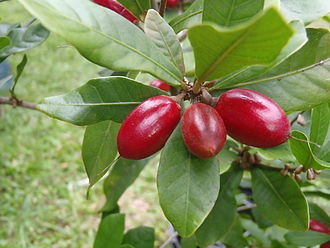In recent years, consumers pursuing healthier eating habits have spurred demand for sweetening agents that won’t rot our teeth while turning our (maybe you, definitely not me) washboard abs into washtubs. In turn, our quest for sugar substitutes has led to an evolution of the range of sweetening agents.
Meet the miracle berry of West Africa, which tricks the tongue by making sour foods taste sweet. But not really. This little red berry contains a protein called miraculin, which apparently attaches to our taste buds, especially in the presence of acids that give foods a sour taste. When the sweet receptors are activated by acids, voila!
That lemon? That lime? Both are as sweet as the nectar of a tangerine. You will impress your friends as you eat chili pepper after chili pepper with the remark, “I could eat these sweets all day!” Which you won’t be able to, actually. Your gustatory magic trick will work for about an hour. That’s when the effect of this natural sugar substitute wears off.
Found in the berries of the plant
Synsepalum dulcificum, miraculin binds to the sweetness receptor “a million times stronger than the artificial sweetener aspartame and 100 million times
stronger than sugar,” notes Jennifer Walsh. The stronger the compound binds, the sweeter the taste, she reports.
SWEETEN YOUR KNOWLEDGE ABOUT SWEETENERS
There are two categories of sweeteners: nutritive/caloric and non-nutritive/non-caloric,
according to Shalini S. Dewan, BCC Research analyst. Nutritive/caloric sweeteners include high fructose corn syrup (HFCS), sugar alcohol, and maltodextrin. Nutritive sweeteners provide about four calories per gram. Some caloric sweeteners are made by processing sugar compounds, while others occur naturally.
Non-nutritive sweeteners, explains Dewan, “provide zero calories, hence the name non-caloric sweeteners. These chemically processed compounds, which are added in very small amounts to foods for a significant sweetening effect, have been approved by various regulatory agencies for use in a number of dietetic or reduced-calorie foods and beverages. Non-nutritive sweeteners include both artificial and natural sweeteners like the miracle berry.”
Non-sugar sweeteners provide consumers with a sweet taste without the calories or carbohydrates. These type of sweeteners help consumers meet their need to manage their weight, maintain their physical appearance and stay in better overall health, says Dewan. These products include aspartame, acesulfame-K, sucralose, saccharin, cyclamate, neotame and, more recently, natural stevia.
FLAVOR FAD: FLAVOR-TRIPPING WITH THE MIRACLE BERRY
The attention-grabbing properties of the “magical fruit” known as miraculin has inspired “flavor-tripping parties” where diners can experience its magic on a smorgasbord of acidic foods.
“Guests take either the berries or the pills made with the miraculin extract before sampling an assortment of normally savory consumables,” reports
Oliver Noble. He says foods such as lemons, chili peppers and beer seem to yield the most extreme results.
According to Dewan, the global market for
sugar and non-sugar sweeteners in 2013 was $104.1 billion, which jumped to $106.9 billion in 2014. The overall sugar and sweeteners market is expected to reach $122.8 billion by 2019. She says the sugar market is expected to rise at a compound annual growth rate (CAGR) of 2.6% and reach nearly $104.7 billion by 2019.
“Non-sugar sweeteners grew from $14.1 billion in 2013 to $14.7 billion in 2014,” Dewan adds. “This market is estimated to rise at a CAGR of 4.3% and be worth nearly $18.2 billion by 2019. This growth is due to increased health consciousness, awareness and use of non-sugar based
dietary foods. In addition, the growing population of overweight, obese and diabetic patients globally is fueling growth in this category” she explains.
The global market for sugar and non-sugar sweeteners seems poised for healthy growth. Sounds a lot like the lifestyles of consumers across the globe. And that’s sweet.




